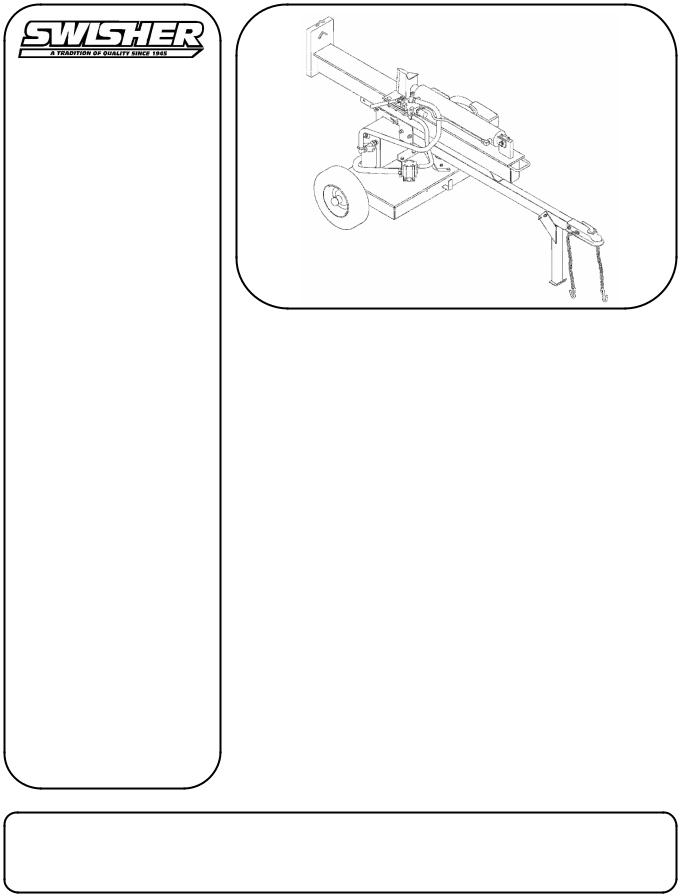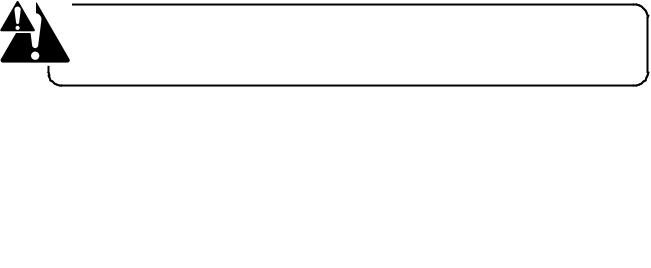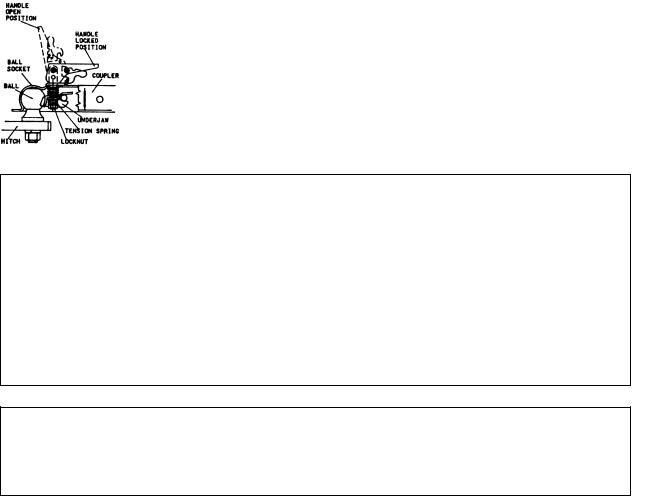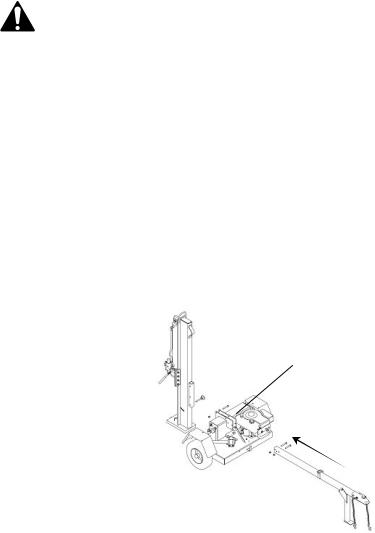Swisher LS622, LS826, LS934, LS10534D, LS57525 User Manual

swisherinc.com
OWNER’S MANUAL
MODEL NO. LS622 LS67525 LS928 LS11534 LS12534D
IMPORTANT
Read and follow all Safety Precautions and Instructions before operating this equipment.
Rev. 04-303
LOG
SPLITTER
Safety
Assembly
Operation
Service and Adjustment
Repair Parts
1602 CORPORATE DRIVE, WARRENSBURG, MISSOURI 64093 PHONE 660-747-8183 Made In The
FAX 660-747-8650
Manufacturing quality lawn care equipment since 1945 USA
10032

LIMITED WARRANTY
The manufacturer’s warranty to the original consumer purchaser is: This product is free from defects in materials and workmanship for a period of two (2) year from the date of purchase by the original consumer purchaser. We will repair or replace, at our discretion, parts found to be defective due to materials or workmanship. This warranty is subject to the following limitations and exclusions:
1)Engine Warranty All engines utilized on our products have a separate warranty extended
to them by the individual engine manufacturer. Any engine service difficulty is the responsibility of the engine manufacturer and in no way is Swisher Mower Co., Inc. or its agents responsible for the engine warranty. The Briggs & Stratton Engine Service Hot-Line is 1-800- 233-3723. The Tecumseh Engine Service Hot-Line is 1-800-558-5402.
2)Commercial Use The warranty period for any product used for commercial or rental is
limited to ninety (90) days from the date of original purchase.
3)Limitation This warranty applies only to products which have been properly
assembled, adjusted, and operated in accordance with the instructions contained within this manual. This warranty does not apply to any product of Swisher Mower Co., Inc., that has been subject to alteration, misuse, abuse, improper assembly or installation, shipping damage, or to normal wear of product.
4) Exclusions Excluded from this warranty are normal wear, normal adjustments, and normal maintenance. The pump, valve, and cylinder each carry separate manufacture’s warranties. The valve and cylinder both carry a one (1) year limited warranty. The pump carries a two (2) year limited warranty.
In the event you have a claim under this warranty, you must return the product to an authorized service dealer. All transportation charges, damage, or loss incurred during transportation of parts submitted for replacement or repair under this warranty shall be borne by the purchaser. Should you have any questions concerning this warranty, please contact us toll-free at 1-800-222-8183. The model number, serial number, date of purchase, and the name of the authorized Swisher dealer from whom you purchased the mower will be needed before any warranty claim can be processed.
THIS WARRANTY DOES NOT APPLY TO ANY INCIDENTAL OR CONSEQUENTIAL DAMAGES AND ANY IMPLIED WARRANTIES ARE LIMITED TO THE SAME TIME PERIODS STATED HEREIN FOR ALL EXPRESSED WARRANTIES. Some states do not allow the limitation of consequential damages or limitations on how long an implied warranty may last, so the above limitations or exclusions may not apply to you. This warranty gives you specific legal rights and you may have other rights, which vary from state-to-state. This is a limited warranty as defined by the Magnuson-Moss Act of 1975.
TABLE OF CONTENTS
WARRANTY………………....….2 |
MAINTENANCE.…………………….8-9 |
SAFETY..……………………….3-4 |
DECALS…..………….……………….10 |
TOWING..….……..……………..5 |
PARTS BREAKDOWN…………….11-18 |
OPERATION……………………6-8 |
SPECIFICATIONS..…………………23 |
2

SAFETY PRECAUTIONS
This Safety Alert Symbol indicates important messages in this manual.
When you see this symbol, carefully read the message that follows and be
alert to the possibility of personal injury.
Read this manual completely. This machine can amputate hands, feet, and throw objects.
Failure to observe the following safety instructions could result in serious injury or death.
WARNING: The engine exhaust from this product contains chemicals known to the state of California to cause cancer, birth defects or other reproductive harm.
DANGER: Your log splitter was built to be operated according to the rules for safe operation in this manual. As with any type of power equipment, carelessness or error on the part of the operator can result in serious injury. If you violate any of these rules, you may cause serious injury to yourself or others.
•Read the manual. Learn to operate this equipment in a safe manner.
•Do not under any circumstances alter this log splitter. This equipment was designed and engineered in accordance with operating instructions. Altering this equipment, or using this equipment in such a way as to circumvent its design capabilities and capacities, could result in serious injury or fatality and WILL VOID THE WARRANTY.
•Allow only responsible adults who have read this manual to operate this machine. Never allow children to operate this machine.
•Never use splitter for any other purpose than splitting wood. Any other use can result in injury. Your splitter is a precision piece of power equipment, not a toy. Therefore, exercise extreme caution at all times.
•Only a single operator is to load and operate the log splitter. Keep all others, including pets and children, a minimum of 20 feet away from your work area. More accidents occur when more than one person operates the log splitter than any other time.
•Always disconnect the spark plug wire and place the wire where it cannot contact the spark plug, to prevent accidental starting the engine when setting up, transporting, adjusting or repairing.
•Always wear protective gear such as safety goggles, protective hearing device, steel-toed shoes, and tight-fitting gloves without drawstrings or loose cuffs.
•Never wear loose clothing or jewelry that can be caught by moving parts of the splitter
and pull you into it. Keep hair away from moving parts.
•Familiarize yourself with all of the controls in a safe environment before starting to work with this machine.
3
Fluid escaping from a very small hole can be almost invisible. Do not check for leaks with your hand. Escaping fluid under pressure can have sufficient force to penetrate skin, causing serious personal injury. Leaks can be located by passing a piece of cardboard or wood over the suspected leak and looking for discoloration. IF injured by escaping fluid, see a doctor at once. Serious infection or reaction can develop if proper medical treatment is not administered immediately.
•Split only one log at a time. Never attempt to split two logs on top of each other.
•Do not straddle or reach across the splitting area while operating the splitter.
•Do not step over splitter when the engine is running. You may trip or accidentally
activate the splitting wedge. Walk around to get to the other side.
•Never place hands or feet between log and splitting wedge or between log and ram during forward or reverse stroke.
•Never attempt to load splitter while splitting wedge is in motion. When loading log splitter, place hands on the sides of the log, not the ends.
•Only use your hands to operate the control lever. Never use foot, knee, rope or any extension device.
•Always keep fingers clear of splits that open in log during splitter operation.
•When splitter is in the return mode, keep hands off the machine.
•Only operate splitter on level ground, not on the side of a hill. It could tip or rolling logs, poor footing, etc. could cause an accident.
•Never operate or allow someone to operate this equipment while under the influence of alcohol or drugs.
•Always block the wheels to prevent movement while using splitter.
•Never operate your splitter on wet, muddy, or icy surfaces. Safe footing is essential in preventing accidents.
•Never operate your splitter while it is attached to the tow vehicle.
•Never make adjustments or repairs with the engine running.
•Never attempt to split woods across the grain. Some types of wood may burst or fly out of your splitter and result in injury.
•Both ends of the log should be cut as squarely as possible to prevent the log from sliding out of the splitter during operation. Log length should be kept to 24” or less.
4

TOWING SAFETY
•Do not allow persons to ride on splitter. Do not carry any cargo or wood on your splitter. It may fall off and endanger vehicles that are following you.
•Be sure jack stand is in the travel position and coupling secure. This must also be retracted so not to interfere while towing. Retract kickstand by removing pin, rotating up, and replacing pin.
•Never exceed 45 MPH while towing your splitter. Be extra cautious when traveling over rough terrain, especially over railroad tracks.
•Always be careful while backing your splitter. You could jackknife your log splitter if not careful.
•Before using splitter, disconnect it from tow vehicle. A log could easily be pushed forward into the vehicle.
•See tire and wheel specifications for PSI while towing.
•Be aware of the extra length of splitter while turning, parking, crossing intersections, and in all driving situations.
|
OPERATION INSTRUCTIONS |
|
POSI-LOCK COUPLER |
||
|
||
|
ADJUST COUPLER LOCKING PRESSURE ON BALL BEFORE USE. PLACE HANDLE IN LOCKED
POSITION WITH BALL IN COUPLER. TIGHTEN LOCKNUT AGAINST TENSION SPRING SO THAT COUPLER IS NOT LOOSE ON BALL. CORRECT ADJUSTMENT WILL ALLOW HANDLE TO BE RELEASED WITH MODERATE PRESSURE APPLIED TO HANDLE.
TO OPEN, PULL UP ON COUPLER HANDLE AND ROTATE FORWARD. PLACE COUPLER ON BALL WHEN BALL IS COMPLETELY NESTED IN BALL SOCKET, ROTATE COUPLER HANDLE BACKWARD UNTIL HANDLE IS IN LOCKED POSITION.
AFTER TOWING FOR 50 MILES, CHECK COUPLER FOR TIGHTNESS ON BALL. ALWAYS CHECK TIGHTNESS BEFORE TOWING. BE SURE COUPLER HANDLE IS IN LOCKED POSITION.
WARNING: NEVER EXCEED WEIGHT CAPACITY AND ALWAYS USE SAFETY CHAINS. ALWAYS USE CORRECT BALL SIZE, MAKING SURE BALL IS COMPLETELY INSERTED INTO COUPLER. LOCK COUPLER HANDLE SECURELY BEFORE TOWING. ALWAYS CHECK FOR DAMAGES AND REPLACE IF DAMAGED. AVOID SHARP TURNS AND STEEP VERTICAL ANGLES WHEN TOWING.
5

OPERATION
Intended use: This log splitter is intended and designed to only split wood. NEVER use for any other purposes. Doing so can cause injury or VOID THE WARRANTY.
ASSEMBLY INSTRUCTIONS
This log splitter has been partially assembled at the factory. Refer to the drawings and part lists should it become necessary to disassemble the unit for repair or replacement of parts. Inspect all components for damage. WARNING: Exercise extreme caution, as parts are very heavy. Sufficient persons or mechanical handling equipment should be used. IMPORTANT: This unit is shipped with oil but without gasoline in the engine. After assembly, see separate Engine Manual for proper fuel and oil recommendations.
1. General Assembly: Remove top, sides and ends of crate. Place crate panels aside to avoid puncturing tires. Remove tongue assembly from top.
Carefully set the beam pre-assembly aside.
Attach tongue to tank/mount plates using two bolts and nuts. Be certain hardware is secure. (See Assembly Figure 1) Remove tank/engine assembly from base of crate and discard banding.
Fender Assembly: Remove fenders from box. Mount to fender brackets with 5/16 hardware provided. Make sure fender clears wheel. The cylinder is tied to the base. Remove ties and slide cylinder/wedge forward aligning clevis at cylinder end to beam. Insert pin and retaining clips, check component to assure proper assembly. Stand beam pre-assembly vertical and secure in position. Roll tank/engine assembly into place, aligning pivot holes. Bolt with provided hardware. Note: Do not over tighten; this is the vertical/horizontal pivot point.
Tank/Mount Plates
Assembly Figure 1
Pivot beam assembly into the horizontal position and lock with pin provided. Hose Assembly: Locate the Pressure Hose, noted by the pipe fittings, and attach it to the lower fitting on the valve. The remaining hose attaches to the top fitting of the valve. Secure with provided hose clamp. Check both the horizontal and vertical positions for any “kinks” in the hoses. Note: Always make sure beam is locked securely into place.
See OPERATING POSITIONS for Horizontal to Vertical Splitting
6

OPERATION
FILLING THE HYDRAULIC RESERVOIR
Fill the hydraulic reservoir with at least five gallons of Dextron III Automatic Transmission fluid or 10W AW hydraulic fluid. After the hydraulic reservoir and the engine crankcase are filled correctly with their respective oils, start the engine. Remember to set the throttle and turn on the fuel shut-off valve. The hydraulic pump should prime itself. With the engine running, move the hydraulic valve lever toward the wedge. This will cause the cylinder to extend and expel air. When the cylinder is fully extended, retract it. Repeat this procedure several times. An erratic movement of the cylinder indicates that there is still air in the system. More oil should then be added to bring the fluid level up to approximately 1” below the fill hole. After adding more oil to fill the tank, cycle the cylinder again until it has a constant speed indicating that all air has been expelled. Check the oil level in the reservoir again. Standard models require approx. 6.5 gallons of hydraulic fluid. (Deluxe models – 9 gallons)
NOTE: If the tank is overfilled, it will tend to expel oil from the breather cap when the cylinder is retracted.
START UP WARNING: DO NOT START OR RUN THE LOG SPLITTER WITHOUT OIL IN THE ENGINE AND HYDRAULIC RESERVOIR.
See separate Engine Manual for fuel and oil recommendations. Your log splitter has come equipped with a fuel shut-off valve for towing purposes. Before starting engine make sure crankcase is filled correctly with oil and the proper fuel has been used. The engine will only start when the throttle lever and fuel shut-off valve are turned to their ON positions.
COLD WEATHER START UP
The Cold Weather Clutch enables the engine to be started without having to pull through cold, thickened hydraulic fluid. Simply pull the handle out and slide into locked position. Start engine, let it warm up, and release Cold Weather Clutch. After starting, assure that the lever has reengaged.
TOWING
This unit should not be towed on any street, highway, or public road without checking the existing federal, local, and state laws. Any licensing or modifications such as taillights, etc., need to comply with existing federal, local, or state vehicle requirements is the sole responsibility of the purchaser. Obey all regulations when towing on public roads and highways. See also TOWING SAFETY.
Be sure you are using the correct ball hitch size for the hitch coupler on the log splitter (2” ball). Be sure safety chains are properly connected. Leave enough slack in chains for turning. See TOWING SAFETY to read warnings about coupling.
Make sure beam attachment is locked in the horizontal position. NEVER tow splitter in the vertical position.
Turn the fuel shut-off valve OFF to prevent flooding of the engine while traveling.
TOWING AT NIGHT
The requirements for taillights are based on States regulations. Some states allow towing at night as long as the towed equipment does not visibly impair the tow vehicle taillights. This is based on a state, to state requirements. The customer is responsible for meeting the states requirements. A Taillight Kit Accessory (Part No. 7420)is available and recommended for night driving.
If a “Statement of Origin” is required in your state, see your local dealer to receive one.
7

OPERATION
1. Set up the log splitter in a clear, level area and block the wheels. The suction port on the tank should always be on the lower side of the log splitter.
2. Place a log on the beam, against the foot plate. Make sure the log is securely on the foot plate and up against the beam.
3. Depress the valve lever so that the cylinder will drive the wedge into the log. Extend the cylinder until the log splits or to the end of its stroke. If the log has not completely split after the cylinder has reached the end of its extension, retract the cylinder. NOTE:
Leaving the valve in the “actuate” position at the end of the stroke may damage the pump.
OPERATING POSITIONS
WARNING: THE LOG SPLITTER BEAM IS HEAVY AND CAN PINCH HANDS/FINGERS IF CARE IS NOT TAKEN.
STANDARD HORIZONTAL TO VERTICAL The Standard Splitter has 2 operating positions: Horizontal, Vertical. Remove pin from below beam. Do not remove bolt and nut. Rotate beam into vertical position and pin so beam cannot fall into horizontal position.
DO NOT TOW IN VERTICAL POSITION!
IMPORTANT: When operating splitter in wooded areas, obtain a spark arrestor for the exhaust system. See your local engine dealer.
When preparing logs, cut ends as square as possible. The maximum length of any logs should be only 24”.
MAINTENANCE & STORAGE
WARNING: Disconnect spark plug before performing any maintenance or making adjustments.
RESERVOIR FLUID Check the hydraulic fluid level in the reservoir tank before each use. Operating without an adequate oil supply will cause severe damage to the pump. Change the hydraulic fluid in the reservoir per manufacturers recommendations.
Be aware of the environment when disposing of used petroleum products. Please dispose of used hydraulic fluid, engine oil and any by products from the maintenance of your log splitter at approved recycling centers.
Should it become necessary to loosen or remove any hydraulic fitting or line, be sure to remove all pressure by shutting off the engine and moving the control handle back and forth several times.
NEVER remove the cap from the hydraulic tank or reservoir while your unit is running. Hot oil under pressure will cause injury.
Always store gasoline in an approved, tightly sealed container. Store container in a dry, cool place. Keep fuel away from gas appliances where fumes could contact open flame, pilot lights or sparks.
8
